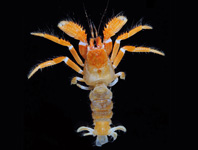Abstract
The Cerrado is the second largest Brazilian biome, and is considered to be a “hotspot” due the great concentration of endemic species and high rate of deforestation. Surveys of the mite fauna present in this biome have revealed a great number of new species. In this paper, we describe Tenuipalpus spinosaurus sp. nov. (Acari: Tenuipalpidae), a new species of Tenuipalpus sensu stricto, from adult females, deutonymphs, protonymphs, larvae and eggs, collected on Terminalia argentea (Combretaceae), from the Cerrado in Brazil. Females of this new species bear a prominent longitudinal crest on the opisthosoma. The ontogenetic changes in the idiosoma and leg chaetotaxy of all stages are presented. A key to the world species of Tenuipalpus sensu stricto is provided.
References
Castro, E.B., Ochoa, R., Feres, R.J.F., Beard, J.J. & Bauchan, G.R. (2015) Reinstatement of the genus Colopalpus Pritchard and Baker (1958) and re-description of Colopalpus matthyssei Pritchard and Baker (1958), the type species of the genus (Acari, Tenuipalpidae). International Journal of Acarology, 41 (4), 310–328.
http://dx.doi.org/10.1080/01647954.2015.1031276Castro, E.B., Kane, E.C., Feres, R.J.F., Ochoa, R. & Bauchan, G.R. (2016) Definition of Tenuipalpus sensu stricto (Acari, Tenuipalpidae), with redescription of Tenuipalpus caudatus (Dugès) and description of a new species from Costa Rica. International Journal of Acarology, 42 (2), 106–126.
. http://dx.doi.org/10.1080/01647954.2015.1130941De Leon, D. (1965a) New Tenuipalpidae (False Spider Mites) from British Guiana with notes on four described species. Florida Entomologist, 48 (1), 65–75.
http://dx.doi.org/10.2307/3493527De Leon, D. (1965b) False spider mites of Jamaica and the Dominican Republic (Acarina: Tenuipalpidae). Annals of the Entomological Society of America, 58 (4), 517–523.
http://dx.doi.org/10.1093/aesa/58.4.517Demite, P.R., Feres, R.J.F., Lofego, A.C. & Oliveira, A.R. (2009) Plant inhabiting mites (Acari) from the Cerrado biome of Mato Grosso State, Brazil. Zootaxa, 2061, 45–60.
Donnadieu, A.L. (1876) Recherches pour servir á l’histoire des Tétranyques. Annales de la Societe Linneene de Lyon, 135 pp., pls. 1–12.
Dugès, A. (1834) Recherches pour servir a l'ordre des Acariens en general et la famille des Trombidies en particulier. Annales des Sciences Naturelles Paris, (ser. 2) 1, 5–46.
Flechtmann, C.H.W. (1976) Preliminary report on the false spider mites (Acari: Tenuipalpidae) from Brazil and Paraguay. Proceedings of the Entomological Society of Washington, 78, 58–64.
Klink, C.A. & Moreira, A.G. (2002) Past in current human occupation, and land use. In: Oliveira, O.S. & Marquis, R.J. (Eds), The Cerrados of Brazil. Columbia University Press, USA, pp. 69–88.
Klink, C.A. & Machado, R.B. (2005) A conservação do Cerrado brasileiro. Megadiversidade, 1, 147–155.
Lindquist, E.E. (1985) External anatomy. In: Helle, W. & Sabelis, M.W. (Eds), Spider mites: their biology, natural enemies and control. Vol. 1A. Chapter 1.1 Anatomy, Phylogeny and Systematics. Elsevier Science Publishers, Amsterdam, pp. 3–29.
Lofego, A.C. & Moraes, G.J. (2006) Ácaros (Acari) associados a Mirtáceas (Myrtaceae) em áreas de Cerrado no Estado de São Paulo com Análise Faunística das famílias Phytoseiidae e Tarsonemidae. Neotropical Entomology, 35, 731–746.
http://dx.doi.org/10.1590/S1519-566X2006000600003Mesa, N.C., Ochoa, R., Welbourn, W.C., Evans, G.A. & Moraes, G.J.de. (2009) A catalog of the Tenuipalpidae (Acari) of the World with a key to genera. Zootaxa, 2098, 1–185.
Myers, N., Mittermeier, R.A., Mittermeier, C.G., Fonseca, G.A.B.da. & Kent, J. (2000) Biodiversity hotspots for conservation priorities. Nature, 403, 853–858.
http://dx.doi.org/10.1038/35002501Rezende, J.M., Lofego, A.C., Nuvoloni, F.M. & Navia, D. (2014) Mites from Cerrado fragments and adjacent soybean crops: does the native vegetation help or harm the plantation? Experimental and Applied Acarology, 64 (4), 501–518. http://dx.doi.org/10.1007/s10493-014-9844-5
Seeman, O.D. & Beard, J.J. (2011) A new species of Aegyptobia (Acari: Tenuipalpidae) from Myrtaceae in Australia. Systematic and Applied Acarology, 16, 73–89. http://dx.doi.org/10.11158/saa.16.1.10
Vasconcelos, G.J.N., Da Silva, F.R., Barbosa, D.G.F., Correa, M.G. & de Moraes, G.J. (2005) Ocorrência de Eriophyoidea, Tenuipalpidae, Tarsonemidae e Tukerellidae (Acari) em fruteiras no Estado de Pernambuco, Brasil. Caatinga, 18 (2), 98–104.
Xu, Y. & Fan, Q.-H. (2010) Tenuipalpus orilloi Rimando, a new record to the Chinese fauna (Acari: Tenuipalpidae). Systematic and Applied Acarology, 15, 135–138.
http://dx.doi.org/10.11158/saa.15.2.8

